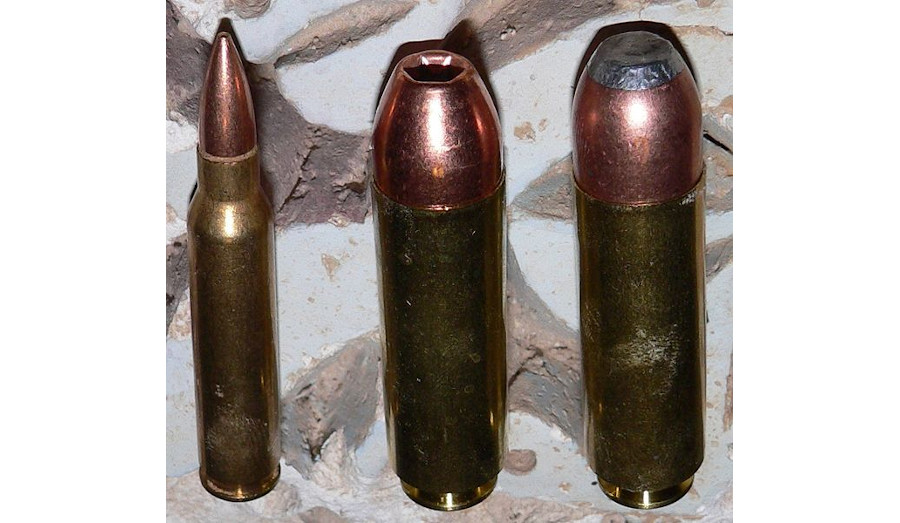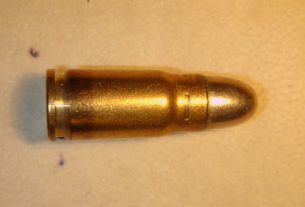Every now and then, AR-15 owners may feel the need for something a little more powerful than the standard 5.56mm NATO chambering. Whether it’s hunting big game, stopping cars, or punching through brick walls, sometimes you just need a little more oomph. That normally means a bigger bore and a lot more power. And over the years, the market for big-bore AR-15 cartridges has narrowed itself down to two primary competitors: the .458 SOCOM and the .50 Beowulf.
The .50 Beowulf is similar in origin to the now-defunct .499 Leitner-Wise cartridge. A straight-walled cartridge based on a lengthened .50 Action Express pistol case, the .50 Beowulf features a base diameter of .535 inches with a rebated rim diameter of .445 inches, the same as the 7.62x39mm and 6.5 Grendel cartridges, and fires .500-inch 50-caliber pistol bullets.
The case capacity of the .50 Beowulf is similar to the .500 S&W Magnum revolver cartridge, but it operates at a much lower pressure. Because of the higher bolt thrust from the wider diameter cartridge, .50 Beowulf pressures have to be kept significantly lower than the 55,000-62,000 psi at which the 5.56 NATO operates, generally at around 35,000 psi.
Despite the low pressures, the .50 Beowulf puts up pretty impressive ballistics, more than surpassing the energy of standard .45-70 loads, and putting it pretty close in terms of muzzle energy to larger cartridges such as the .308 Winchester. The most commonly available loads feature bullets in the 300- to 400-grain range, with 300-grain bullets leaving the muzzle at 2,050 feet per second, 335-grain bullets at 1,900 feet per second, and 400-grain bullets at 1,800 feet per second, for about 2,800 foot-pounds of muzzle velocity.
Heavier bullets can be loaded too, with 500-grain bullets leaving the muzzle at 1,450 feet per second. Those who cast their own lead bullets can even load .50-caliber bullets intended for the .500 S&W Magnum, with weights up to 700 grains and velocities beginning to drop into the subsonic range.
One of the drawbacks of the .50 Beowulf is its limited magazine capacity. Because of the fatter cartridge, a standard 30-round AR-15 magazine can only fit 10 Beowulf cartridges, while the 20-round magazines can only fit 7 rounds, and 10-round magazines only fit 4. The .50 Beowulf was intended to be able to chamber from standard .223-caliber AR-15 magazines, although Beowulf-specific magazines exist. And if you can find .499 Leitner-Wise magazines, those will work with the Beowulf too.
Another problem with the .50 Beowulf is that, like the .458 SOCOM, it’s a proprietary cartridge that hasn’t been standardized by SAAMI. As a result of its popularity, numerous other manufacturers have tried to reverse-engineer the cartridge, calling their versions the 12.7x42mm. And as with the .458 SOCOM, not all of those reverse-engineered versions perform properly, leading to feeding problems, short-stroking, etc.
The .50 Beowulf is also a straight-walled cartridge, meaning that feeding will be slightly more difficult than for the bottlenecked .458 SOCOM. For handloaders, getting case overall length right is more important than for the .458 SOCOM, otherwise there could be problems with headspace and primer ignition.
Despite those potential problems, the .50 Beowulf is a potent and capable cartridge. And if you’re looking for real big-bore power while sticking to the AR-15 platform, it’s one of only two real options available to you. If you do your research and determine that you need the .50 Beowulf’s power, it certainly will hold its own in any survival situation.
Image: Wikipedia
This article was originally posted on Red Tea News.





